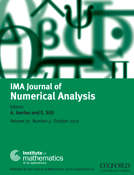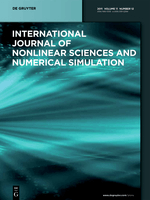
COMPUTERS & MATHEMATICS WITH APPLICATIONS
Scope & Guideline
Exploring the Synergy of Computers and Mathematics
Introduction
Aims and Scopes
- Numerical Methods and Algorithms:
The journal emphasizes the development and application of numerical methods for solving mathematical problems, particularly those arising in physics and engineering. - Computational Modeling:
It covers a wide range of computational models, including fluid dynamics, heat transfer, and biological systems, emphasizing their mathematical foundations and practical implementations. - Error Analysis and Stability:
Papers often focus on the stability and error analysis of numerical methods, providing rigorous assessments of various computational techniques. - Adaptive and Multiscale Methods:
The journal features research on adaptive methods and multiscale approaches that improve computational efficiency and accuracy for complex problems. - Interdisciplinary Applications:
Research published in the journal spans multiple disciplines, including materials science, environmental engineering, and biomedical applications, showcasing the versatility of computational mathematics.
Trending and Emerging
- Physics-Informed Neural Networks (PINNs):
The integration of machine learning techniques, particularly physics-informed neural networks, is gaining traction for solving partial differential equations, showcasing the convergence of traditional methods with modern computational intelligence. - Adaptive Mesh Methods:
Adaptive mesh methods are increasingly popular, emphasizing the need for efficient computational techniques that can handle complex geometries and varying solution characteristics. - Multiscale and Multiphysics Approaches:
There is a growing emphasis on multiscale and multiphysics modeling, which allows for the simulation of complex systems that involve interactions across different scales and physical phenomena. - Data-Driven Methods:
Research focusing on data-driven modeling and simulation techniques is on the rise, reflecting the increasing availability of data and the need for computational methods that can leverage this information effectively. - Hybrid Computational Techniques:
Hybrid methods that combine different numerical approaches are emerging, allowing for enhanced flexibility and accuracy in solving challenging mathematical problems.
Declining or Waning
- Traditional Finite Element Methods:
There seems to be a waning interest in traditional finite element methods, as researchers increasingly explore hybrid and virtual element methods that provide greater flexibility and efficiency. - Basic Computational Techniques:
Basic computational techniques are less frequently reported, indicating a shift towards more complex and sophisticated algorithms and methods that address contemporary challenges. - Static Problem Formulations:
Research focusing solely on static problem formulations is declining as the field moves towards dynamic and time-dependent problems that better reflect real-world scenarios.
Similar Journals

Computational Methods in Applied Mathematics
Pioneering Research in Computational MethodologiesComputational Methods in Applied Mathematics is a premier academic journal published by WALTER DE GRUYTER GMBH, based in Germany. With its ISSN 1609-4840 and E-ISSN 1609-9389, this journal serves as a crucial platform for the dissemination of cutting-edge research and innovations in the fields of Applied Mathematics, Computational Mathematics, and Numerical Analysis. Notably, it has been recognized in 2023 with a Q2 ranking in its category quartiles, marking it as a significant contributor in its discipline. Spanning from 2001 to 2024, it fosters interdisciplinary collaboration and exploration of computational methodologies that solve complex mathematical problems. Though it operates on a traditional access model, its relevance is underscored by its Scopus rankings, which place it among the notable leaders in its area. As a trusted source of scholarly articles, Computational Methods in Applied Mathematics is an essential resource for researchers, professionals, and students aiming to stay abreast of advancements and discussions that shape the future of applied mathematics.

IMA JOURNAL OF NUMERICAL ANALYSIS
Transforming Ideas into Numerical SolutionsIMA Journal of Numerical Analysis, published by Oxford University Press, stands as a premier platform for cutting-edge research in the field of numerical analysis, exemplifying the latest advancements and methodologies in applied, computational, and general mathematics. Since its inception in 1981, this esteemed journal has continually contributed to the academic community by publishing high-quality, peer-reviewed articles that foster innovation and collaboration among researchers. With an impressive Q1 ranking across multiple categories, including Applied Mathematics and Computational Mathematics, it plays a crucial role in disseminating knowledge, as indicated by its Scopus rankings which place it in the top 25% of journals within its field. Although the journal is not open access, it remains a vital resource for academics, professionals, and students eager to engage with the ongoing evolution of numerical methods. By serving as a conduit for novel ideas and rigorous research, the IMA Journal of Numerical Analysis ensures that its contributors and readers are at the forefront of this dynamic discipline.

ADVANCES IN COMPUTATIONAL MATHEMATICS
Elevating the Standards of Applied MathematicsADVANCES IN COMPUTATIONAL MATHEMATICS, published by Springer, is a leading international journal dedicated to the dynamic and rapidly evolving fields of Applied Mathematics and Computational Mathematics. With an impressive Q1 ranking in both categories as of 2023, the journal serves as a vital platform for researchers and professionals to disseminate innovative methodologies and computational techniques that address complex mathematical challenges. Operating since 1993 and continuing to contribute substantially to the academic landscape through 2024, it boasts a robust reputation within the mathematics community, underscored by its Scopus rankings—#230 out of 635 in Applied Mathematics and #80 out of 189 in Computational Mathematics. This journal, based in the Netherlands, emphasizes cutting-edge research while offering a wealth of access options to facilitate scholarly communication. As such, ADVANCES IN COMPUTATIONAL MATHEMATICS stands as an essential resource for anyone interested in the forefront of computational techniques and mathematical theory.

Computational Thermal Sciences
Fostering Collaboration in Cutting-edge Thermal ResearchComputational Thermal Sciences, an esteemed journal published by BEGELL HOUSE INC, presents cutting-edge research at the intersection of computational mathematics, energy engineering, and fluid dynamics. With an ISSN of 1940-2503 and an E-ISSN of 1940-2554, this journal aims to disseminate high-quality research articles, reviews, and methodologies that improve our understanding of thermal processes and their applications. Renowned for its solid impact in the field, it holds a Q3 ranking in multiple categories including Computational Mathematics and Energy Engineering for 2023. As the field evolves, the journal continues to play a pivotal role in bridging theoretical research with practical innovations, thereby catering to a diverse audience of researchers, professionals, and students. Although it operates on a subscription model, the journal ensures accessibility to significant contributions in thermal sciences from 2009 to 2024, fostering an environment of knowledge sharing and collaboration.

INTERNATIONAL JOURNAL OF NONLINEAR SCIENCES AND NUMERICAL SIMULATION
Pioneering Research in Nonlinear PhenomenaINTERNATIONAL JOURNAL OF NONLINEAR SCIENCES AND NUMERICAL SIMULATION, published by WALTER DE GRUYTER GMBH, serves as a premier platform for advancing knowledge in the vibrant domains of applied mathematics, computational mechanics, and various fields of engineering and physics. With an ISSN of 1565-1339, this journal has been at the forefront of disseminating significant research findings since its inception in 2000. Its commitment to quality is reflected in its category quartiles for 2023, ranked Q2 in Computational Mechanics and Engineering (miscellaneous), and Q3 in multiple engineering disciplines. Although it currently operates under a subscription model, the journal remains dedicated to presenting groundbreaking studies that explore complex nonlinear phenomena and numerical methodologies. As an invaluable resource for researchers, professionals, and students alike, the journal aims to foster innovation and collaboration across related fields, enhancing both theory and application through its peer-reviewed articles.

JOURNAL OF ENGINEERING MATHEMATICS
Innovating solutions through rigorous mathematical exploration.Welcome to the JOURNAL OF ENGINEERING MATHEMATICS, a leading scholarly platform published by Springer that has contributed significantly to the fields of engineering and mathematics since its inception in 1967. With an esteemed Q2 ranking in Engineering and a Q3 ranking in Mathematics according to the latest categorization, this journal is recognized for its rigorous peer-reviewed content that showcases innovative research across various mathematical and engineering disciplines. Researchers and professionals alike will find valuable insights within its pages, as it covers theoretical developments and practical applications that are pivotal for advancing knowledge in these critical areas. The journal maintains a robust presence in the global academic landscape, evidenced by its positioning in the 74th percentile for General Mathematics and 52nd percentile for General Engineering in Scopus rankings. As we look forward toward our convergence years spanning from 1967 to 2024, the JOURNAL OF ENGINEERING MATHEMATICS continues to invite submissions that foster interdisciplinary dialogue and exploration, making it an essential resource for students, academics, and industry experts.

Computation
Advancing knowledge through computational insights.Computation, published by MDPI, is an esteemed open-access journal that has been contributing to the fields of applied mathematics and computer science since its inception in 2013. With an E-ISSN of 2079-3197, this Swiss-based journal operates under a philosophy of free knowledge dissemination, allowing researchers, professionals, and students globally to access high-quality content without financial barriers. Recognized for its rigorous peer-review process, Computation is currently categorized in the Q2 and Q3 quartiles across significant domains, including Applied Mathematics (#181/635), Theoretical Computer Science (#52/130), and Modeling and Simulation (#138/324). As it converges towards 2024, the journal continues to attract innovative and impactful research aimed at advancing theoretical frameworks and practical applications within these disciplines. Joining the Computation community not only enriches individual research portfolios but also contributes to the broader conversation on computational methodologies and their applications in solving real-world problems.

JOURNAL OF COMPUTATIONAL MATHEMATICS
Empowering Researchers with Robust Mathematical MethodologiesJOURNAL OF COMPUTATIONAL MATHEMATICS, published by GLOBAL SCIENCE PRESS, is a distinguished peer-reviewed academic journal dedicated to advancing the field of computational mathematics. With a focus on high-quality research that bridges theoretical and practical applications, this journal aims to disseminate innovative methodologies and robust algorithms that address complex mathematical problems. Operating without an open-access model, it maintains a reputable standing with a Q2 category classification in computational mathematics as of 2023, showcasing its influence and relevance within the academic community. The journal, which has been in publication since 1996, continues to evolve, providing a platform for researchers, practitioners, and students to engage with cutting-edge developments up to 2024. By contributing to the body of knowledge in computational mathematics, this journal plays a vital role in fostering collaboration and advancement in related disciplines.

ESAIM-Mathematical Modelling and Numerical Analysis
Innovating Solutions through Numerical ExcellenceESAIM-Mathematical Modelling and Numerical Analysis, published by EDP SCIENCES S A, is a prestigious open-access journal at the forefront of the fields of mathematical analysis, applied mathematics, computational mathematics, modeling, simulation, and numerical analysis. With an impressive Q1 ranking in multiple categories for 2023, the journal is recognized for its contribution to advanced research, particularly in areas that intertwine mathematical theory with practical applications. The journal’s ISSN is 2822-7840 and its E-ISSN is 2804-7214, showcasing its commitment to both traditional and digital dissemination of knowledge. Spanning from 1996 to 2024, ESAIM has established itself as a vital platform for scholars seeking to publish innovative research and engage with the latest advancements in the field. Researchers and practitioners can explore the journal’s content through various access options, fostering a collaborative environment for the sharing and development of new mathematical methodologies. Situated in France, ESAIM continues to attract an international readership, driving forward the global discourse in mathematical sciences.

NUMERICAL METHODS FOR PARTIAL DIFFERENTIAL EQUATIONS
Transforming mathematical analysis through peer-reviewed excellence.Numerical Methods for Partial Differential Equations is a prestigious academic journal published by Wiley, dedicated to advancing the field of numerical analysis and computational mathematics. With a prominent standing reflected in its Q1 rankings across multiple categories including Analysis, Applied Mathematics, Computational Mathematics, and Numerical Analysis, this journal serves as a vital resource for researchers, professionals, and students alike. Since its inception in 1985, NUMERICAL METHODS FOR PARTIAL DIFFERENTIAL EQUATIONS has consistently published high-quality, peer-reviewed articles that explore innovative numerical techniques and their applications across disciplines. The journal is indexed in leading databases, ensuring broad visibility and access for its contributors. Aimed at fostering cutting-edge research, it invites submissions that provide new insights and methodologies for solving complex partial differential equations, making it an essential source for anyone interested in the intricacies of mathematical analysis and computational techniques.